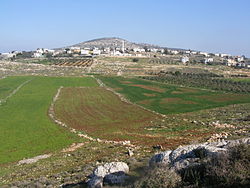Rumat al-Heib
Rumat al-Heib
רומת אל-הייב رُمة الهـَيـْب | |
|---|---|
 Rumat al-Heib, 2011 | |
 Rumat al-Heib | |
| Coordinates: 32°46′39″N 35°18′26″E / 32.77750°N 35.30722°ECoordinates: 32°46′39″N 35°18′26″E / 32.77750°N 35.30722°E | |
| Country | |
| District | Northern |
| Council | Al-Batuf |
| Founded | 1920s |
| Population (2019)[1] | 2,047 |
Rumat al-Heib (Arabic: رُمة الهـَيـْب; Hebrew: רומת אל-הייב) is a Bedouin village in northern Israel. Located near Nazareth in the Lower Galilee, it falls under the jurisdiction of the al-Batuf Regional Council. In 2019 its population was 2,047.[1]
History[]
British Mandate era[]
The village was established at the beginning of the 1920s by members of the Arab al-Heib tribe and was originally named after the family.[citation needed]
In the 1931 census the population was counted with nearby Rumana, and together they had 197 inhabitants; 195 Muslims and 2 Christians, in a total of 36 houses.[2]
1948, Israel[]
The al-Heib Bedouin tribe was one of the several Bedouin allies of the Jewish military forces during the 1948 Arab–Israeli War, actively participating in securing the lower Galilee and the Beit She'an Valley from Arab paramilitaries and the Arab Liberation Army. The al-Heib fighters later formed the core of the Minorities Unit of the Israel Defense Forces. Up to this day, many of the al-Heib men conscript for a full service in the IDF, and many also volunteer for professional military service. The Bedouin Soldier memorial is located in the vicinity of the village.[citation needed] In 2007, there were tensions between the village and the nearby moshav of Tzippori, with the Bedouins accused of cattle rustling.[3]
References[]
- ^ Jump up to: a b "Population in the Localities 2019" (XLS). Israel Central Bureau of Statistics. Retrieved 16 August 2020.
- ^ Mills, 1932, p. 75
- ^ New version of old self-defense group guards Jewish farmlands Haaretz, 28 December 2007
Bibliography[]
- Mills, E., ed. (1932). Census of Palestine 1931. Population of Villages, Towns and Administrative Areas. Jerusalem: Government of Palestine.
External links[]
- Arab villages in Israel
- Al-Batuf Regional Council
- Populated places in Northern District (Israel)
- 1920s establishments in Mandatory Palestine
- Populated places established in the 1920s

